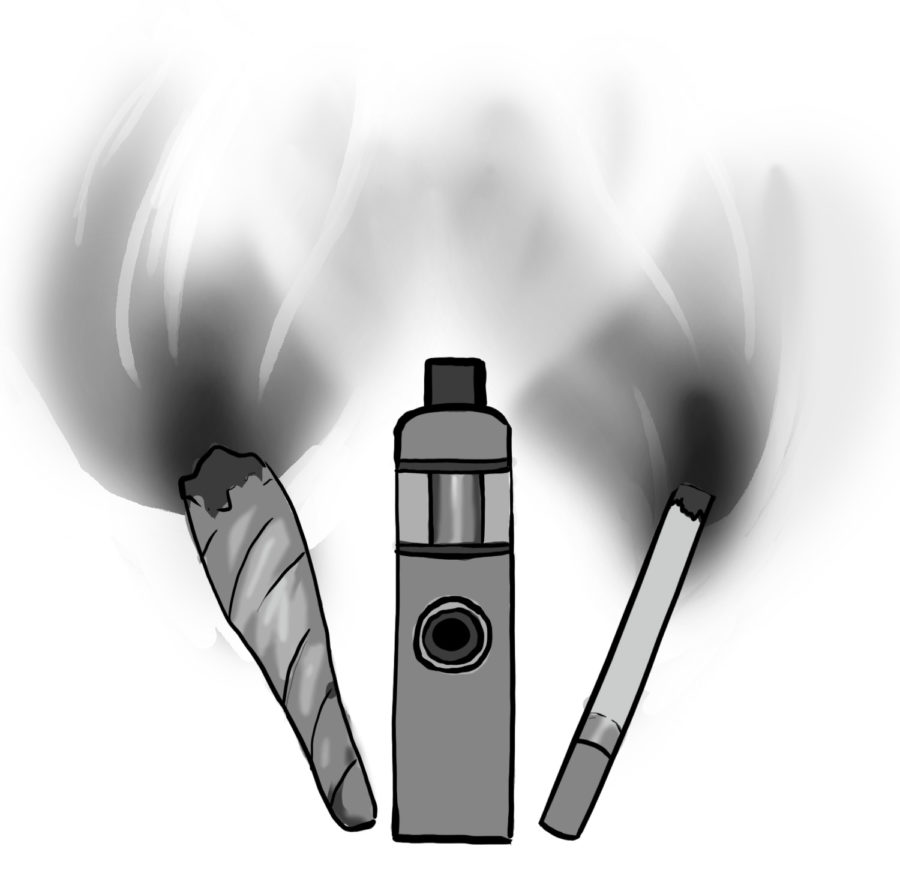State and federal legislators work to combat vaping rise
September 24, 2019
Vaping, whether it be nicotine or THC, has become an extremely popular trend among teenagers in the past several years. With long-term effects still largely unknown, individuals of authority, on local and national levels, have been taking action.
In a recent district-wide email sent out on Sept. 4 by Student Assistance Program Coordinators Keith Bullock and Diana Benoist, the risks and rules surrounding vaping were outlined once again in light of news deaths related to vaping-related illnesses.
The email states that, “Despite news headlines about the harms of vaping that have lead to severe lung disease, hospitalizations, and even death, vaping’s popularity continues to rise nationally and locally, and threatens our students’ physical, mental, and social well-being.”
The Illinois state government has also responded to these issues: on April 7, Illinois Governor J.B. Pritzker signed legislation that raised the smoking age from 18 to 21.
According to the bill, nicotine-based products such as vapes were also included. However, an additional law put into place by Pritzker called the Cannabis Regulation and Tax Act (HB 1438) will, among other things, formally legalize use of marijuana for adults 21 and over starting Jan. 1, 2020.
The raising of the legal smoking and vaping age has come as a response to a massive increase in vaping numbers over the past several years—especially among teens.
A 2018 study conducted by the National Institute on Drug Abuse reported that “use of vaping nicotine specifically in the 30 days prior to the survey nearly doubled among high school seniors from 11 percent in 2017 to 20.9 percent in 2018.”
Vaping products with nicotine such as JUUL are not the only problem, though. Studies also present a massive increase in vaping marijuana through cannabidiol (CBD) pens over the past few years as well for several reasons.
According to Green Entrepreneur, CBD vape sales grew 105 percent in 2018 alone. The article states that CBD pens have become popular because the human body absorbs between 34 and 46 percent of its compounds. By contrast, the human body typically absorbs only about ten percent of the cannabidiol from edible marijuana.
The district email also highlighted how this new technology has enabled far heavier concentrations of THC to be consumed when vaping with CBD pens.
“These marijuana extracts are highly concentrated and contain extraordinarily high THC levels ranging from 40-80%,” the email stated, “This form of marijuana can be up to four times stronger than ‘top shelf’ marijuana, which normally measures around 20% THC (By comparison, the average THC level in marijuana in the 1970’s was less than 2%).”
Controversy has spread throughout the country regarding how to solve the issue of the rise in teenage vaping, especially after several new cases of vaping-related deaths.
As of the morning of Sept. 10 according to the Washington Post, six total deaths have been reported as a result of vaping-related lung illnesses, with over 470 total illness cases.
These cases are one of the first pieces of evidence that may outline the severity of vaping’s long term effects.
Most recently, President Trump has formally announced that a major crackdown on flavored vapes and e-cigarettes is in the works, with the primary focus of limiting access of vapes to teenagers.
“We can’t allow people to get sick. And we can’t have our kids be so affected,” Trump said.
With the vaping epidemic becoming more and more serious as deaths nationwide continue to pop up, the district’s email urged that there are many things students and their parents can do to avoid a dangerous addiction or disease.
“Although it may not always feel like it, research shows that parents still have significant influence over whether their teen chooses to use substances like vaping,” the email stated, “With the first vaping death reported last week [as of the time of email’s release], don’t wait to talk with your kids about vaping.”



























